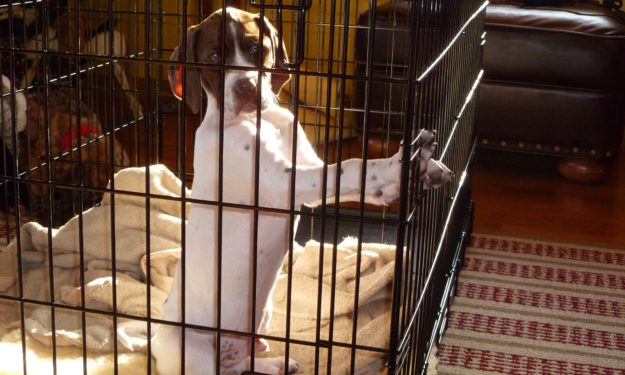Puppy Training 101: How to Crate Train a Puppy at Night

Written by Nancy Thompson, CVT
Puppies can be a handful and get into all sorts of trouble. Crate training is a wonderful tool to help calm your puppy, create a safe space for them, and prevent anxiety. Additionally, this training method can help you housebreak your puppy in a way that mimics what wolves and coyotes do in the wild. By following these simple steps you can have a puppy that will learn to love their crate and be housebroken with confidence.
Why should I crate train my puppy?
Crate training is an effective method for house training your puppy when you can’t constantly keep an eye on them while they roam freely around your home. Dogs in the wild seek out “dens” where they can feel safe and sheltered while resting, caring for puppies, or recovering from an illness or injury. It is a dog’s natural instinct not to go to the bathroom in their den, which means they usually won’t soil their crate. Crate training also creates a safe space for puppies when traveling, when you have company over and he/she gets too rambunctious, or when you aren’t home to keep him/her safe from chewing on electrical cords, furniture, or eliminating in other areas of the house.
How do I choose which crate to get?
Make sure your crate is well ventilated and big enough for them to stand up, turn around, and lie down. Remember your puppy will be growing so be sure to purchase a crate that is appropriate for your dog’s expected full-grown size. While they’re still growing, you can use a divider to make the crate smaller for the time being (many crates come with dividers when purchased). Size does matter: if the crate is too small, it will be uncomfortable for your dog. But if a crate is too large, it will give your dog the space they need to have an accident without ruining the bedding. This behavior might encourage future accidents in the crate and around your home.
How do I teach my puppy to love the crate?
The most important part of crate training is making sure your puppy ALWAYS associates their crate with a positive experience. Here’s a few tricks to try to make their crate a good thing:
- Line the crate with a blanket and place a few toys inside to make it cozy.
- Cover the crate with a lightweight blanket to mimic a “den” environment. Make sure it is still well ventilated and not too hot to do this.
- Bring your puppy to the crate for naps and quiet-time breaks so he/she can “unwind” from playing or any type of chaos that could be going on in the house. Start in increments of 10 minutes and work up to longer periods.
- Offer a treat when he/she goes inside or some other distraction toy such as a stuffed KONG.
- Make sure your puppy is exercised and they’ve gone to the bathroom before putting them in their crate.
- Feed their meals in their crate so that crate=food=good!
- Keep your puppy in the crate overnight. They may cry the first night or two but in most cases, they are simply adjusting to being in a new home with out their littermates and mom. Puppies generally can sleep through the night without having to go out by about 4 months of age but if they wake you up, you should always take them outside.
What NOT to do when crate training
- Never leave a puppy in their crate all day: he/she needs several bathroom breaks as well as play and feeding times throughout the day. Even though they won’t want to soil their sleeping area, they may if they’re in there for extremely long periods of time (they can’t help it!)
- Never use the crate as punishment: your puppy should see his/her “room” as a place where only happy and peaceful things happen.
- Never lose your patience, learning takes time.
Following these tips and staying consistent will help your puppy learn to love the crate for years to come. We wish you many happy, fun, puppy days to come! Good luck and if you ever need anything or have any questions, we are here.